Excerpts from Jim Conrad's
Naturalist Newsletter
from the February 25, 2008 Newsletter issued from near Vicente Carranza in Mexico's southernmost state, CHIAPAS
OLEANDERS FLOWERING
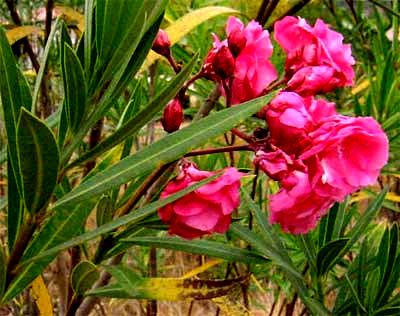
Above you see the oleanders, NERIUM OLEANDER, flowering outside my door these days. When I read what my little Golden Nature Guide Exotic Plants has to say about the species I'm not surprised that it refers to oleanders as "the most popular ornamental of all warm areas."
Nothing is more typical here in Mexico than for a town's streets and parks to be planted with thousands of white-, pink- and red-flowering oleander varieties. Oleanders are even favored in such semitropical and non-tropical places as California, deep Texas, and on coastal islands of the US Carolinas, where their salt tolerance also is appreciated. The only thing detracting from the oleander's excellence as an ornamental shrub is that all parts of the plant are highly poisonous.
It's hard to interpret flower anatomy on the plants outside my door because they're double-flowered horticultural monstrosities, as I suppose most garden oleanders are nowadays. In double-flowered varieties, typically the plant breeder has caused stamens or other flower parts to abnormally develop into colorful petals, in much the same way that sometimes on a chicken's leg feathers arise where scales should be.
Wild oleanders in their Mediterranean homeland bear flowers with funnel-shaped corollas, and each flower's throat is set with five frilly teeth. They're neat, elegant blossoms with each flower-part reflecting the wisdom of eons of evolution and answering to particular needs of specific local pollinators.
But flowers on the bushes outside my door answer to nothing but the human appetite for ever-larger splashes of gaudiness everywhere all the time. My double-flowered oleanders look uncannily like double-flowered begonias, double-flowered camellias, double- flowered buttercups, double-flowered roses, and all the other double-flowered varieties they've come up with.
from the September 18, 2011 Newsletter issued from Mayan Beach Garden Inn 20 kms north of Mahahual; Caribbean coastal beach and mangroves, ~N18.89°, ~W87.64°; Quintana Roo state, MÉXICO
AN ESPECIALLY SMALL, PINK-FLOWERED OLEANDER
Next to the main building a dwarf, pink-blossomed oleander is at its peak of flowering, as shown below:
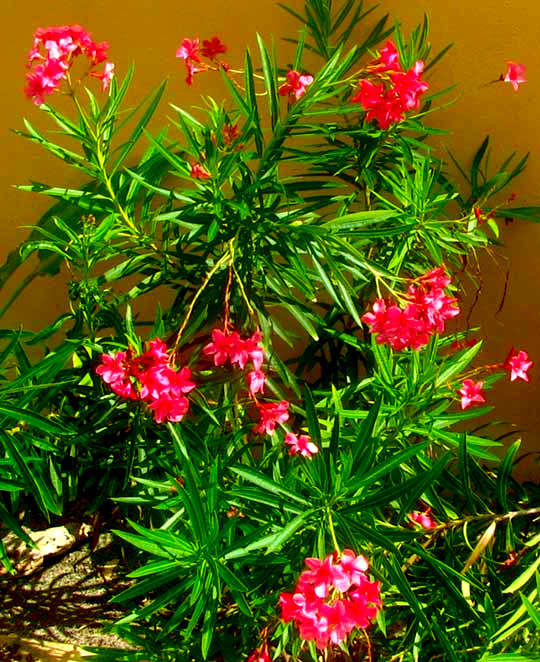
Most oleanders, which are NERIUM OLEANDER, are taller, up to 20 feet (6m), less bushy, and often have leaves with a grayer bloom. But there's a whole world of different kinds of oleanders, because of their prettiness, drought tolerance and ability to thrive in poor soil and fairly polluted air. Oleanders are among the world's most planted woody species, at least in warmer areas. Over 400 cultivars have been named, some with flower colors not generally seen in Nature. You might enjoy browsing a page featuring many oleander cultivars -- ones with evocative names like "Marrakesh," "Mary Constance," "Mrs. Kelso," "Sister Agnes" and "Pleasant's Postoffice Pink" -- at http://www.oleander.org/varieties.html.
If you have a highly modified oleander cultivar, how do you know you have a real oleander?
For one thing, an oleander's flower clusters, or inflorescences, arise at the end of branches and are of a particular form. They're known technically as "terminal branching cymes," with cymes being defined as more or less flat-topped inflorescences with their central flowers opening first, as shown below:
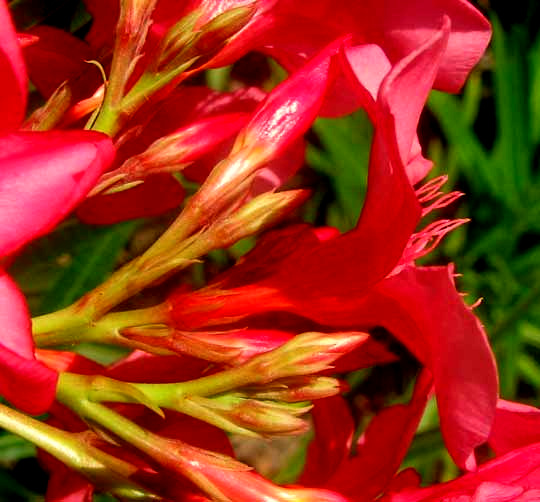
Looking down a flower's throat you see what's shown below:
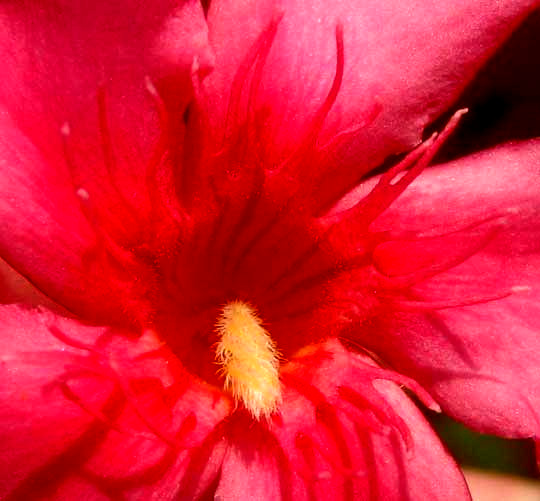
Like last week's yellow-flowered vine, Pentalinon luteum, there's a fuzzy thing hanging from the flower's mouth, plus, unlike the Pentalinon luteum, around the throat there's a fringe of slender, pink, fingerlike items. That fringe is something special distinguishing oleander flowers from many closely related types. It's analogous to the crown or corona on flowers such as daffodils. You can see how -- as in last week's Pentalinon -- the fuzzy things consist of hairy "anther appendages" arising from five anthers forming a tepee over a roundish stigma head below:
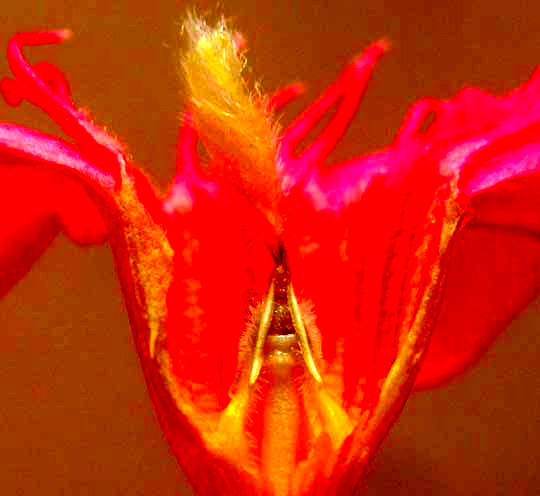
You might enjoy comparing our view down the throat of our pink blossomed oleander with a similar look down the throat of a taller, tree-type, white-flowered oleander growing across the road, shown below:
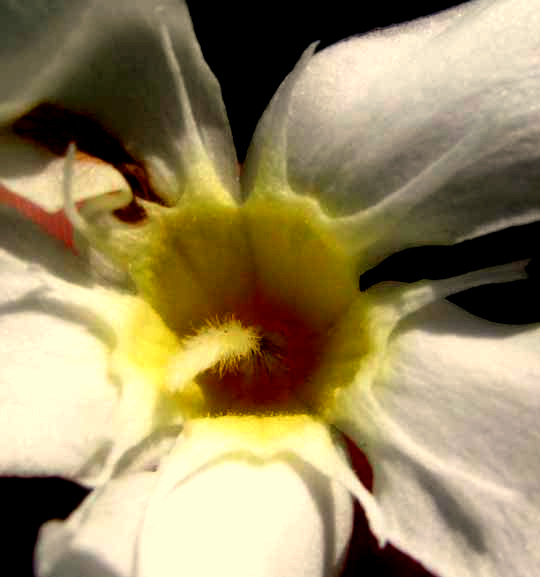
Besides the color difference, the white flower's fringe is less finely divided. "Variations on an oleander theme... "
If you've been following our recent analyses of flowers you already know that -- because of those tepee-like anthers over the roundish stigma head -- oleanders are yet another member of the Dogbane Family, the Apocynaceae.
Oleanders are thought to be native to the drier areas of Eurasia and northern Africa.
from the September 18, 2011 Newsletter issued from Mayan Beach Garden Inn 20 kms north of Mahahual; Caribbean coastal beach and mangroves, ~N18.89°, ~W87.64°; Quintana Roo state, MÉXICO
HOW POISONOUS ARE OLDEANDERS?
We've all heard that oleanders, like so many members of the Dogbane Family, are poisonous. This is a good time to figure out just how poisonous they are.
Oleander parts contain several compounds known to be poisonous, among them being oleandrin and oleandrigenin. These are "cardiac glycosides," which are used as drugs in the treatment of congestive heart failure and cardiac arrhythmia. They function by increasing the heart's force of contraction.
Rodents and birds don't seem to be much affected by oleander cardiac glycosides, but certain mammals, such as dogs, cattle and humans, do. A research paper on the Internet reports that "Nerium oleander leaves caused the death within 36 hours of 7 of 17 cattle which had access to boughs of the plant." A 1985 paper in the journal Annals of Emergency Medicine reports on a woman who died after drinking "oleander tea." A 1987 paper in the Journal of Analytical Toxicology reports on a woman who took it "both orally and rectally," and died.
So, people definitely can die from oleander poisoning. However, though several urban legends float around -- like the one relating how a Boy Scout troop was killed by roasting wieners on oleander sticks -- there are relatively few documented cases of oleander poisoning. A 1996 paper in the journal Toxicology, abstracted at the National Library of Medicine website, concluded that, except for children who might be at greater risk because of their smaller body size, "human mortality associated with oleander ingestion is generally very low, even in cases of moderate intentional consumption (suicide attempts)."
When I break apart a fresh leaf from the pink-flowered oleander profiled above and with the tip of my tongue taste the broken part, it's so bitter that I can't imagine people accidentally or unthinkingly chewing enough leaf to harm themselves, unless they were bent on suicide. And I can think of many quicker and less disagreeable ways to die than by oleander poisoning.